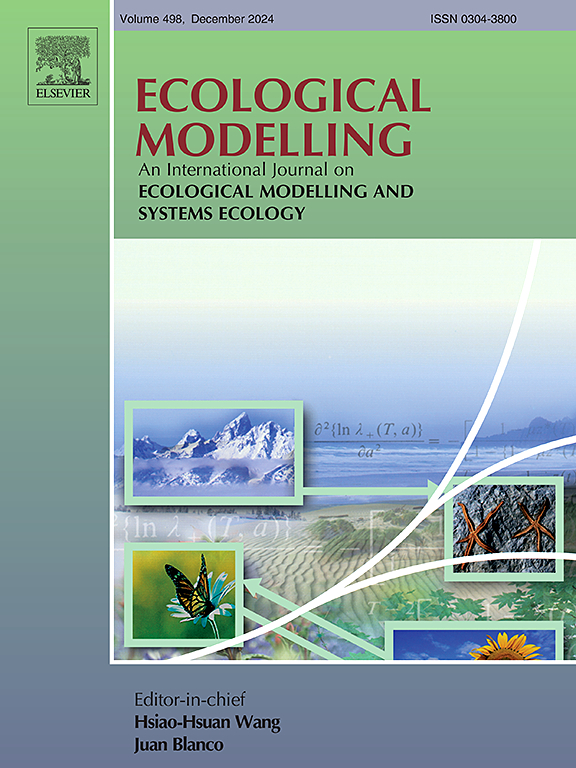将喀斯特裸岩指数(KBRI)纳入CASA模型改进西南喀斯特地区草地地上生物量估算
IF 2.6
3区 环境科学与生态学
Q2 ECOLOGY
引用次数: 0
摘要
地上生物量(AGB)是评价草地生态系统服务价值的重要因子,尤其是在区域尺度上。通常使用卡耐基-艾姆斯-斯坦福方法(CASA)进行估算。然而,由于喀斯特地区地形的空间异质性显著,对CASA的应用存在一定的限制,导致估算AGB的精度较低。本研究旨在将CASA模型与喀斯特裸岩指数(KBRI)相结合,提高西南典型喀斯特地区草地AGB的估算精度。改进的CASA的决定系数(R2)、均方根误差(RMSE)、平均绝对误差(MAE)和建模效率(ME)分别为0.677、76.735 g m-2、65.224 g m-2和0.736。这些值均高于原CASA模型的R2为0.468,RMSE为98.541 g m-2, MAE为71.434 g m-2, ME为0.519。改进的CASA模型的平均值为739.95 g m-2,更接近实测的AGB。因此,将喀斯特裸岩指数纳入CASA模型估算喀斯特地区草地AGB是可行的。研究结果为喀斯特地区草地生产力监测提供了新的思路。本文章由计算机程序翻译,如有差异,请以英文原文为准。
Integrating karst bare rock index (KBRI) into the CASA model to improve grassland aboveground biomass estimation in karst area, Southwest China
Aboveground biomass (AGB) is a vital factor when evaluating the grassland ecosystem service values, especially on regional scales. It is often estimated using the Carnegie-Ames-Stanford Approach (CASA). However, the significant spatial heterogeneity of landforms in karst areas poses limitations for CASA, resulting in low accuracy in estimating AGB. The objective of this study was to combine CASA model with karst bare rock index (KBRI) to improve the estimation accuracy of grassland AGB in a typical karst area, Southwest China. The coefficient of determination (R2), root mean square error (RMSE), mean absolute error (MAE) and modelling efficiency (ME) of the improved CASA are 0.677, 76.735 g m-2, 65.224 g m-2 and 0.736, respectively. These values are higher than those of the original CASA model, which has an R2 of 0.468, RMSE of 98.541 g m-2, MAE of 71.434 g m-2, and ME of 0.519. The improved CASA model showed an average value of 739.95 g m-2, which is closer to the measured AGB. Therefore, it is feasible to estimate the grassland AGB in karst area by integrating karst bare rock index into CASA model. Our results have provided new insights for monitoring grassland productivity in karst areas.
求助全文
通过发布文献求助,成功后即可免费获取论文全文。
去求助
来源期刊

Ecological Modelling
环境科学-生态学
CiteScore
5.60
自引率
6.50%
发文量
259
审稿时长
69 days
期刊介绍:
The journal is concerned with the use of mathematical models and systems analysis for the description of ecological processes and for the sustainable management of resources. Human activity and well-being are dependent on and integrated with the functioning of ecosystems and the services they provide. We aim to understand these basic ecosystem functions using mathematical and conceptual modelling, systems analysis, thermodynamics, computer simulations, and ecological theory. This leads to a preference for process-based models embedded in theory with explicit causative agents as opposed to strictly statistical or correlative descriptions. These modelling methods can be applied to a wide spectrum of issues ranging from basic ecology to human ecology to socio-ecological systems. The journal welcomes research articles, short communications, review articles, letters to the editor, book reviews, and other communications. The journal also supports the activities of the [International Society of Ecological Modelling (ISEM)](http://www.isemna.org/).
 求助内容:
求助内容: 应助结果提醒方式:
应助结果提醒方式:


